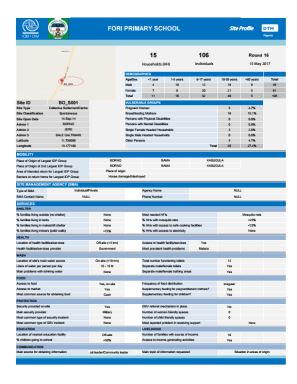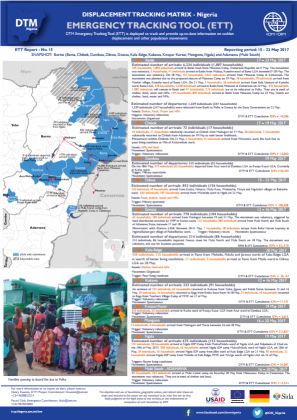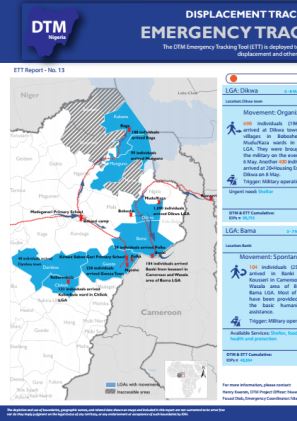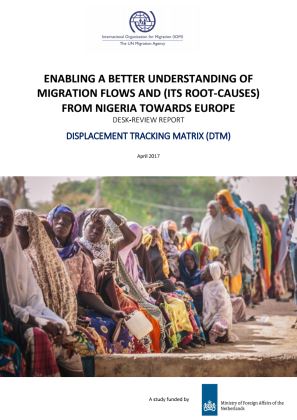-
Countries
-
Data and Analysis
-
Special Focus
-
Crisis Responses
Nigeria
Nigeria
Suivi des PDI
Mouvements de déplacement
3,340,000
IDMC 2023
cycle de collecte de données
À propos Nigeria
The escalation of violence between all parties in north-eastern Nigeria since 2014 has resulted in mass displacement and deprivation in the states of Adamawa, Bauchi, Borno, Gombe, Taraba and Yobe. To better understand the scope of displacement and assess the needs of affected populations, IOM has been implementing its Displacement Tracking Matrix (DTM) programme starting July 2014, in collaboration with the National Emergency Management Agency (NEMA) and State Emergency Management Agencies (SEMAs). The activities of the DTM project, which consist of conducting baseline assessments and registration for IDPs living in camps and host communities, are currently being carried out in Adamawa, Bauchi, Borno, Gombe, Taraba and Yobe.
The information collected will contribute to the provision of a comprehensive profile of the IDP population in Nigeria which will be shared with all relevant stakeholders and will contribute towards enabling the government of Nigeria and humanitarian partners identify the needs of Nigeria's displaced population and develop interventions for providing IDPs necessary assistance.
Contacter
DTM Nigeria
DTMNigeria@iom.int
Bailleurs de fonds
- ECHO
- BHA
- Canada
Nigeria — Flow Monitoring Dashboard 4 (1—30 June 2017)
This dashboard provides an overview of mobility patterns occurring in Nigeria’s northern States of Kano and Sokoto in June 2017. Results show that the daily average number of individuals observed at the flow monitoring point (FMP) in Kano decreased by 31% compared to May.
Nigeria — Emergency Tracking Tool Report 20 (20—27 July 2017)
This Emergency Tracking Tool (ETT) report provides a snapshot on Bama, Chibok, Damboa, Dikwa, Gubio, Gwoza, Jere, Kala Balge, Konduga, Kukawa, Mafa, Monguno, and Ngala. During the reporting period, DTM recorded the movement of 894 individuals in Bama, 478 in Jere and 241 in Gwoza.
Nigeria — Emergency Tracking Tool Report 19 (12—19 June 2017)
DTM Emergency Tracking Tool (ETT) was deployed in Nigeria to track and provide up-to-date information on sudden displacement and other population movements.
Nigeria — Biometric Registration Update Mafa LGA (12—16 May 2017)
During the reporting period 15,074 individuals (6,289 households). Of these 84% were women and children and 24% were children under 5 years old. 41% of the population was male and 59% was female.
Nigeria — Biometric Registration Update Bama IDP Camp (23—31 May 2017)
During the reporting period 6,827 individuals (2,385 households) were identified. Of these, 87% were women and children and 23% were children under 5 years old. 42% of the population was male and 58% was female.
Nigeria — Storm Damage to IDP Sites Flash Report 3 (13 June 2017)
The worst hit of all the camps assessed was Boarding School Camp, with 18 destroyed shelters and 134 partially damaged shelters. EL-Miskin Transit Camp, Kawarmela, Farm Center, Madinatu, Muna Da’lti 1A, 2A and 2B, Muna Moforo and Goni Kachallari Camps were flooded as a result of the storm.
Nigeria — Emergency Tracking Tool Report 18 (6—12 June 2017)
This Emergency Tracking Tool (ETT) report provides a snapshot on Bama, Chibok, Dikwa, Damboa, Gubio, Monguno, Gwoza, Konduga, Kala Balge and Kukawa. During the reporting period, DTM recorded the movement of 1,020 individuals in Bama, 536 in Dikwa and 771 in Gwoza.
Nigeria — Emergency Tracking Tool Report 17 (31 May — 6 June 2017)
DTM Emergency Tracking Tool (ETT) was deployed to track and provide up to date information on sudden displacement and population movements in: Bama, Chibok, Damboa, Dikwa, Gwoza, Kukawa, and Monguno.
Nigeria — Displacement Report 16 (May 2017)
Total number of identified IDPs increased by 51,588 (3%) individuals from last DTM round. The number of identified returnees increased by 83,467 (7%) individuals from the last DTM round.
Jun 01 2017
Nigeria — Displacement Report 16 (May 2017)
Nigeria — Returnee Dashboard 16 (1—30 April 2017)
DTM has identified a total of 1,234,894 individuals returning to their respective homes of which 94,584 (7.7%) individuals are from Cameron, Chad and Niger Republic. The dashboard contains a map displaying the concentration of returnees by area.
Nigeria — List of Wards Assessed 16 (5 April—15 May 2017)
The list of assessed wards includes details with regards to state, local government area (LGA), ward, number of households and number of indiviudals.
Nigeria — List of Displacement Sites Assessed 16 (5 April—15 May 2017)
The list of sites assessed contains information on site number, site ID, site name, state, local government area (LGA), ward name, number of households and number of inviduals.
Nigeria — Adamawa Site Profiles 16 (5 April—15 May 2017)
This document contains all Adamawa site profiles for round 16.
Nigeria — Borno Site Profiles 16 1/2 (5 April—15 May 2017)
This document contains the the first half of Borno site profiles for round 16.
Nigeria — Borno Site Profiles 16 2/2 (5 April—15 May 2017)
This document contains the the second half of Borno site profiles for round 16.
Nigeria — Taraba Site Profiles 16 (5 April—15 May 2017)
This document contains all Taraba site profiles for round 16.
Nigeria — Yobe Site Profiles 16 (5 April—15 May 2017)
This document contains all Yobe site profiles for the round 16 data collection period.
Nigeria — Storm Damage to IDP Sites Flash Report (26 May 2017)
On 27 May 2017, IOM carried out an assessment to ascertain the level of damage sustained in camps and camp-like settings due to the storm on the previous day.
Nigeria - Emergency Tracking Tool Report 15 (15 - 23 May 2017)
DTM Emergency Tracking Tool (ETT) was deployed to track and provide up-to-date information on sudden displacement and other population movements in: Borno (Bama, Chibok, Damboa, Dikwa, Gwoza, Kala Balge, Kukawa, Kwayar Kursar, Monguno, Ngala) and Adamawa (Mubi South).
Nigeria — Emergency Tracking Tool Report 14 (9—15 May 2017)
Included in this Emergency Tracking Tool (ETT) report are Bama, Kala-Bage, Gwoza. Chibok and Monguno. DTM recorded 42,902 IDPs in Bama, 35,706 in Kala-Balge, 60,836 in Gwoza, 12,950 in Chibok, and 1212,823 IDPs in Monguno (cumulative numbers).
Nigeria - Emergency Tracking Tool Report 13 (3—8 May 2017)
The DTM Emergency Tracking Tool was deployed to track and provide up to date information on sudden displacement and other population movements in: Bama, Chibok, Damboa, Dikwa, Gwoza, Kukawa and Monguno.
Nigeria — Migration Flows from Nigeria to Europe Desk Review Report (April 2017)
This desk review report is part of the outputs of the first phase of IOM’s project implementation on data collection to enable a better understanding of migration flows from Afghanistan, Ethiopia, Iraq, Nigeria, Pakistan and Somalia towards Europe.
Nigeria — Emergency Tracking Tool Report 16 (15—23 May 2017)
This snapshot contains Emergency Tracking data on Bama, Chibok, Dikwa, Gwoza, Kukawa, Damboa, Ngala, Kala Balge, and Maiduguri M. C.
Nigeria — Emergency Tracking Tool Report 12 (25 April — 2 May 2017)
Included in this Emergency Tracking Tool (ETT) snapshot are Bama, Biu, Chibok, Dikwa, Gwoza, Monguno, Kaga, Kala/Balge, Yola South, Jere.
Pagination
Pagination
- First page
- Previous page
- 1
- 2
- 3
- 4
- 5
- 6
- 7
- 8
Pagination
- First page
- Previous page
- 1
- 2
- 3
- 4
- 5
- 6
- 7


























